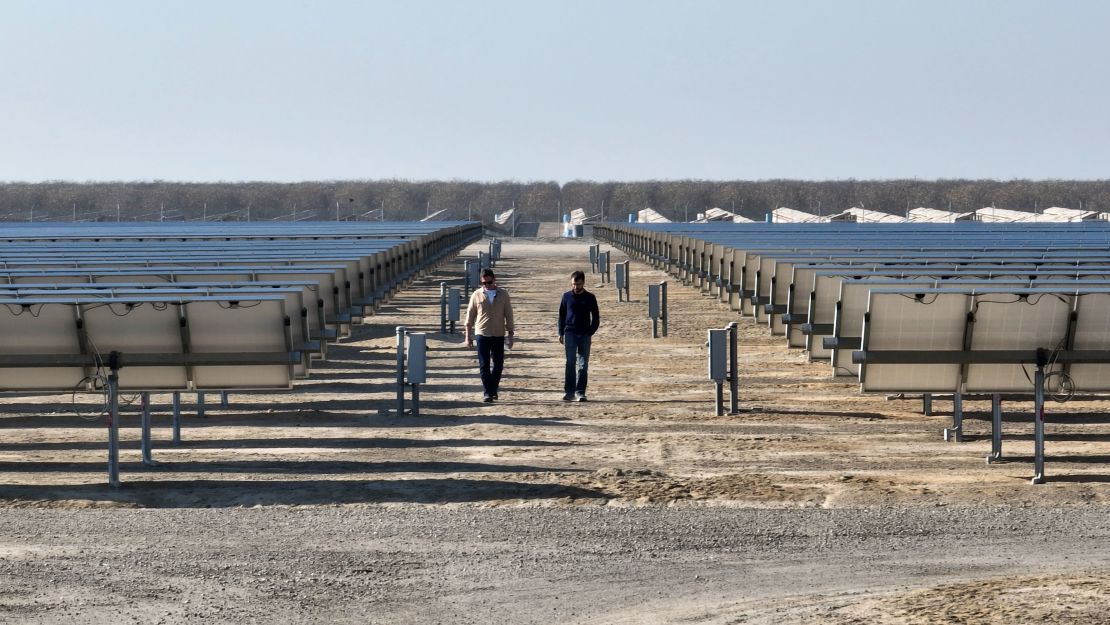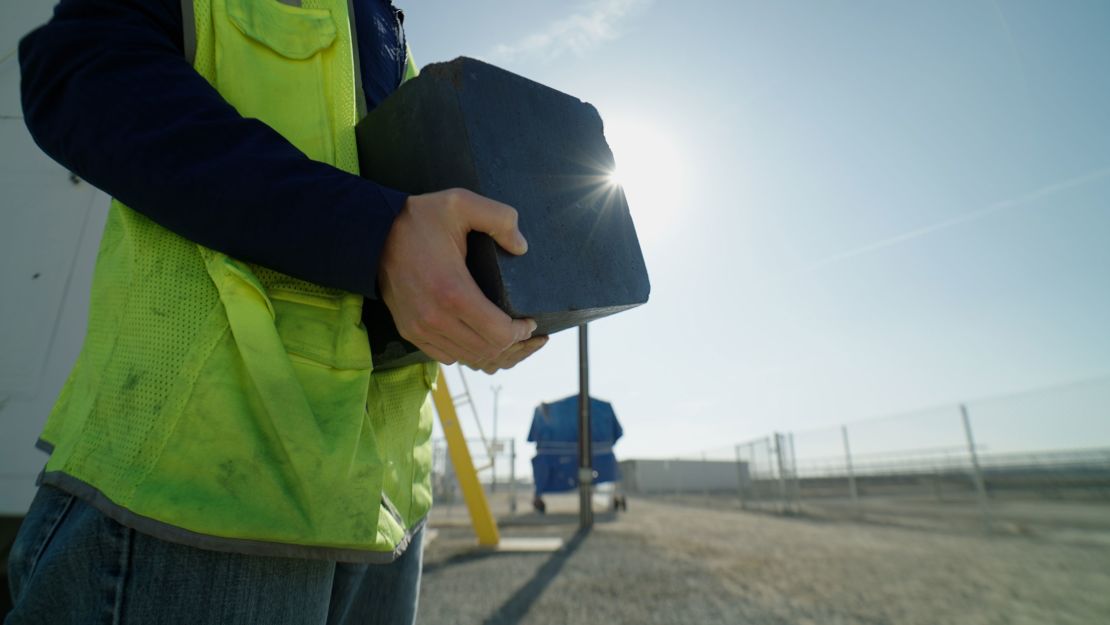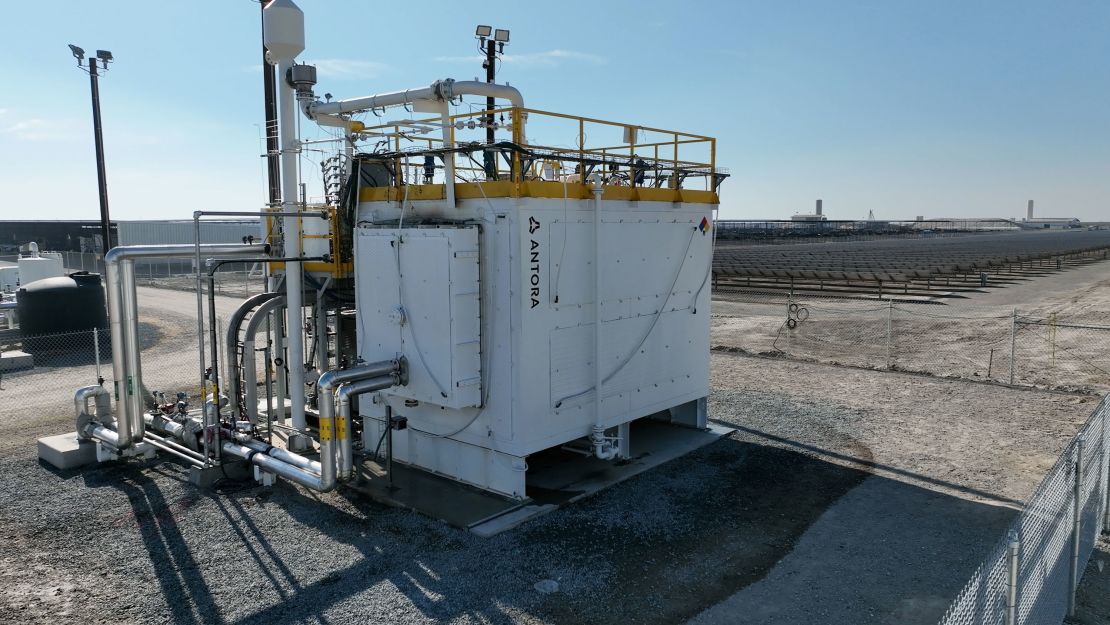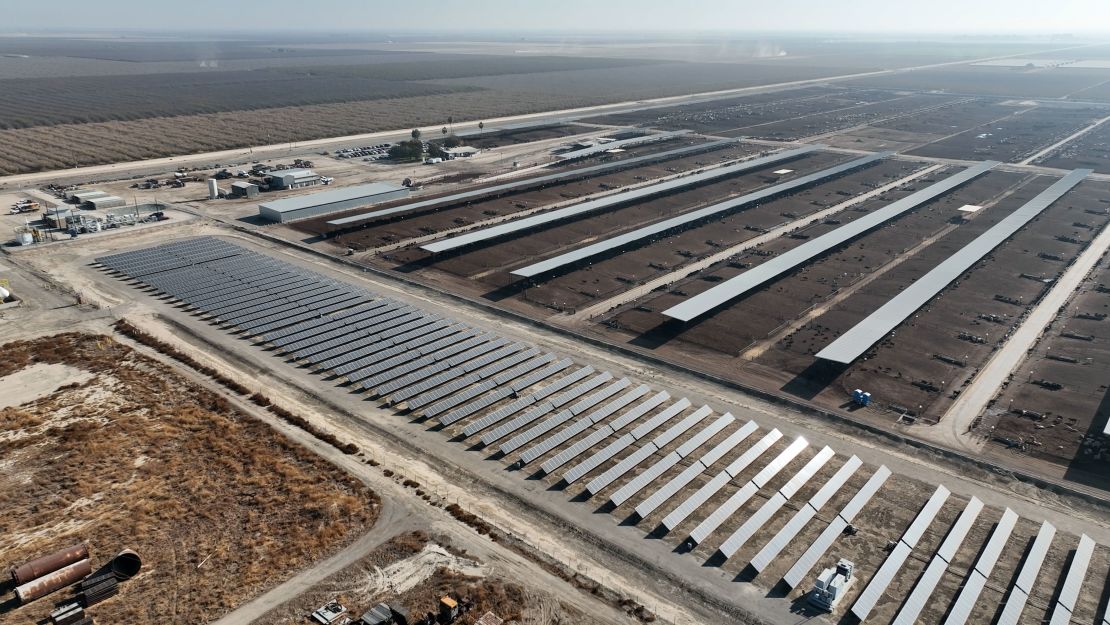Bill Weir, CNN Chief Climate Correspondent
At some point in the dawn of humanity, a smarter-than-average homo sapien moved a rock away from the fire for warmth and invented the thermal battery.
Over a million years later, as humanity struggles to evolve past fossil fuels in time to avoid climate collapse, that simple idea is making a modern comeback – and hot rocks are hotter than ever, literally and figuratively.
“(The rocks) in the box right now are about 1,600 degrees Celsius,” Andrew Ponec said, standing next to a thermal battery the size of a small building. That is nearly 3,000 degrees Fahrenheit, “Hotter than the melting point of steel,” he explained.
But what makes his box of white-hot rocks so significant is they were not heated by burning tons coal or gas, but by catching sunlight with the thousands of photovoltaic solar panels that surround his prototype west of Fresno.

CNN Chief Climate Correspondent Bill Weir (left) walks through Antora Energy's solar field with the company's co-founder and CEO, Andrew Ponec.
If successful, Ponec and his start-up Antora Energy could be part of a new, multi-trillion-dollar energy storage sector that simply uses sun or wind to make boxes of rocks hot enough to run the world’s biggest factories.
“People sometimes feel like they’re insulting us by saying, ‘Hey, that sounds really simple,” Ponec laughed. “And we say, ‘No, that’s exactly the point.’”
Ponec’s clean energy passions began when he was a curious public-school kid tinkering with photovoltaics in his parent’s garage and was lured to drop out of Stanford to build grid-scale solar plants.
When he went back to get his degree, he realized while sun and wind is great for topping off the batteries in cars and homes, there is an even more urgent demand to clean up the fuel sources of industrial heat needed to make everything from baby food to steel. And because a factory’s energy demand is often 24/7, heavy industry has yet to take advantage of the plunging price of renewables.
“Most days in the middle of the day in California, electricity on the wholesale market is free and sometimes even negative dollars, because there’s so much solar that’s now been installed,” Ponec said, “and we’re seeing the same thing in other states with wind. The problem is you can’t shut down your factory when the sun goes behind a cloud or the wind stops blowing, and that’s exactly the problem that we focused on.”
While the word “battery” most likely evokes the chemical kind found in cars and electronics in 2023, hot rocks currently store ten times as much energy as lithium ion around the world, thanks to an invention from the 1800s known as Cowper stoves. Often found in smelting plants, these massive towers of stacked bricks absorb the wasted heat of a blast furnace until it heats to nearly 3,000 degrees Fahrenheit, and then provides over 100 megawatts of heat energy for about 20 minutes.
The process can be repeated 24 times a day for 30 years, and Antora is among the startups experimenting with different kinds of rocks in insulated boxes or molten salt in cylinders to find the most efficient combination.
“We were pretty intrigued by graphite for a number of reasons,” Ponec said. The cheap and abundant carbon found in pencils – which is also used to smelt aluminum and steel – can hold so much heat, it glows hotter than the sun, he said.
“The key thing that those furnaces didn’t have is a way to get the heat back out,” he said. “We’ve added some cavities, some gaps in the carbon that allow light from deep within the system to shine out and some insulated doors that can open and close that allow that light to shine out when you want it. In the future, we’ll be using that light not just to create steam, but to create much higher temperature heat for industries like cement and steel.”

Ponec holds a carbon block like what's used in Antora's thermal battery.

The box that contains the super-heated carbon blocks, which Ponec said were hotter than the melting point of steel.
Antora has managed to raise $80 million in seed money from investors that include Bill Gates, but their main competitor is another Bay Area startup called Rondo that uses abundant refractory brick, which is cheaper than carbon by weight but not as energy dense. Rondo has attracted even more funding than Antora and its first battery is producing commercial power for an ethanol plant in California.
“We had this breakthrough that lets us heat brick directly with infrared, invisible light from heating elements,” Rondo CEO John O’Donnell told CNN. “Right away we knew with third-party engineering reports that this stuff is going to last 100 years.”
Tesla recently predicted a carbon-free world will need an astonishing 240 terawatt-hours of energy storage – more than 340 times the amount of storage built with lithium-ion batteries in 2022. O’Donnell predicts more than half of all that new capacity will come in the form of heat batteries, simply because the raw ingredients are so readily available.
By plugging their factories into as many thermal batteries as they need, manufacturers won’t have to wait in a years-long line for grid connections and upgrades. Given those financial considerations, the old phrase “dumb as a box of rocks” may have to be revised for this new industrial revolution.
“Exciting technologies are great if you’re a venture capitalist and death if you’re a banker,” O’Donnell said. “And it is the bankers and the infrastructure finance folks that like this whole class of technologies. It’s not particularly sexy, but that’s a really good thing.”
“Both companies do heat and power storage,” said Jesse Jenkins, a professor of engineering at Princeton University. “And I think like hydrogen, which similarly has a flexible role to play, it is this kind of long duration storage technology that I’m most optimistic about.”
Jenkins, who specializes in macro-scale energy systems, is also a consultant for Rondo and says the hot rocks model has a distinct advantage over chemical batteries that can store power, but not heat.
“If you can do both, you can ride the cost curves and scaling advantages in the larger industrial sectors, whereas some of the more pure-play electrochemical battery companies are in a make-or-break moment,” Jenkins told CNN.

The rocks are heated by thousands of photovoltaic panels that surround the Antora Energy prototype west of Fresno.
Both the Andora and Rondo CEOs attended the COP28 climate summit in Dubai where the power of Middle East petrostates was enough to weaken the global commitment to end fossil fuels. But both men came back enthused by the interest in their ideas and the dozens of other breakthroughs in clean energy.
“If you’d asked me five or 10 years ago, I would have said, I’m not sure we have everything we need to decarbonize,” Ponec said strolling through the solar array that powers his battery while a gas-fired power plant sat quiet and idle nearby. “But today, we have the tools we need. We just need to deploy them. The transition is inevitable. It’s going to happen. And if you talk behind closed doors to most of the people in the fossil fuel industry, they’ll say the same thing.”